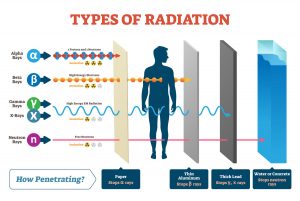Radiologists, radiography machine operators, nuclear power plant engineers, and even you are objects to get radiation exposure. You must keep yourself below the safe level of exposure. But, what if you cannot avoid such a case? Is there a way to reduce or even block all the radiation?
Yap, you can block them but not in a total blockage depending on the type of radiation particle that hits you. You will know it if you keep reading. Another solution of reduction of exposure will be discussed as well in this article.
Keep in mind that the discussion of protecting yourself from radiation in this article is general tips. You can find similar advice on other places. You are better off consulting the radiologists rather than us, and unfortunately, we are not radiologists.
How to Block the Radiation with A Certain Material
In the case when there is a nuclear radiation leak from any nuclear power plant or in the worst case a nuclear explosion then the question of “how to protect yourself from ionizing radiation?” has a different answer.
The first approach is to leave the area where there is an ionizing radiation leak because there is no reliable solution or protection in such cases.
Any short-term solution may include isolating yourself from the outer atmosphere and ionizing radiations. The best way of this is to have a specially made bunker or use your home basement as they can provide the best possible protection.
Depending upon the radiation certain materials, especially metal can protect against radiation. Some tools and gadgets specially developed for this purpose can help but find one domestic market is a bit difficult.
1. Material to Block Alpha
Alpha radiations are the least powerful type of ionizing radiation but still can cause life-threatening damage or injury. The power rating of Alpha radiation is not enough to make then even pass through some easily available material like wood.
A few millimeter thick wood or plastic sheet will be sufficient to stop Alpha radiations from directly penetrating your body.
2. Material to Block Beta
Beta rays are more powerful than Alpha rays but still, their power rating is not sufficient to make them pass through a thick steel metal sheet.
They can easily pass to wood or plastic but steel or a few millimeter thick sheet of any other metal will be sufficient to stop Beta rays.
Any protective shield made from aluminum or tin foil can provide good protection against this type of ionizing radiation.

3. Material to Block X Ray
Although they have a lot of medical-related applications and uses but still they are very dangerous for humans. X-rays can easily pass through wood, plastic, steel, and other metal sheets. It can easily pass through your muscles and other organs.
To protect yourself from X-rays a thick lead plate can be used. Lead is a highly dense metal material and a few-inch thick sheet of lead can block X rays. This is how they stop them in X-rays machine used in hospitals.
4. Material to Block Gamma Ray
In case of an emergency, protecting yourself from ionizing radiations containing gamma rays will be very difficult. Gamma rays are the most powerful among all types of ionizing radiations and even the thickest domestically available metal sheets are not sufficient to stop them.
For protection against gamma rays specially designed chamber made from metal especially lead mixed concrete that is a few feet thick can be used.
How to Reduce the Radiation Exposure
As some professionals can’t avoid ionizing radiation and they are part of their work. So there are several things that they do to get protection from ionizing radiation.
1. Minimize the Time
To minimize the risk of getting exposed to a dose of ionizing radiation, you need to minimize the time spent in the area or with the machine that emits the ionizing radiation.
Less the time you spend handling the ionizing radiation lower will be the chances of you getting exposed to a dangerous dose of the radiation.
2. Maximize the Distance
The second step in minimizing the exposure of ionizing radiation is to maintain a safe distance from the source of radiation. During all the time when you are operating a machine or handling a material that emits radiation, the best practice is to keep distance (as much as possible) from the source.
As radiation loses energy as it travels away from its source so greater the distance from the source lower will be the chances of getting a dangerous dose of ionizing radiation.
3. Follow the Proper Procedure
In today’s advanced world any machine or process that involves ionizing radiations or radioactive material is very well documented and procedures are developed for maximum safety.
In the case where a worker has to deal with ionizing radiation for a considerable amount of time, then proper operation procedures must be adopted to minimize the risk of radiation exposure.
Conclusion
There is no way of completely protecting yourself from ionizing radiations especially X rays and Gamma rays. Metal can provide some resistance but only against Alpha and Beta rays. So best practice is to minimize the time, maximize the distance and use the proper procedure if you have to deal with any radioactive material of ionizing radiations.
Other related pages:
- Best Geiger Counter Reviews
- How Geiger Counter Works
- How to Calibrate the Geiger Counter with A Known Radiation Source
- How to Read & Use Geiger Counter
- How Accurate is Geiger Counter to Measure Ionizing Radiation?
- What is the Safe Level of Ionizing Radiation for Humans?
- Best Dosimeter Reviews
- List of Instruments to Measure Ionizing Radiation
